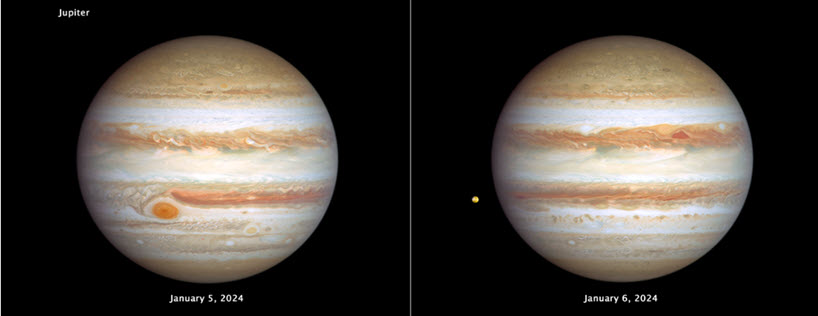Hubble Observes Stormy Weather on Jupiter
Posted on March 15, 2024

Jupiter is known for its active stormy weather pattern. It is home to the Great Red Spot, the largest storm in the solar system.
NASA uses the Hubble Space Telescope to track the weather on Jupiter and other planets as part of its Outer Planet Atmospheres Legacy program (OPAL).
Jupiter is a gas giant with no Earth-like surface. It is covered with largely ammonia ice-crystal clouds. NASA says the bands you see on Jupiter are "produced by air flowing in different directions at various latitudes with speeds approaching 350 miles per hour."
The images above were taken by January 5-6, 2024 and capture both sides of Jupiter. The Great Red Spot can be seen on the left image. It is slightly redder this year than in recent years. An anticyclone dubbed Red Spot Jr. can be seen to its lower right.
The right image also shows a large pair of storms - a deep red cyclone and a reddish anticyclone. NASA says, "These storms are rotating in opposite directions, indicating an alternating pattern of high- and low-pressure systems." Jupiter's innermost moon, Io, can be seen on the left edge of the right image.
OPAL project lead Amy Simon of NASA's Goddard Space Flight Center in Greenbelt, Maryland, says, "The many large storms and small white clouds are a hallmark of a lot of activity going on in Jupiter's atmosphere right now.
Here's a video showing a full rotation of the giant planet Jupiter. To create it, astronomers took Hubble snapshots of Jupiter (January 5-6) and photo-mapped them onto a sphere and rotated the model in animation. NASA says, "The planet's real rotation rate is nearly 10 hours, which is easily plotted by watching the Great Red Spot come and go with each completed rotation."
Image: NASA, ESA, STScI, Amy Simon (NASA-GSFC)
